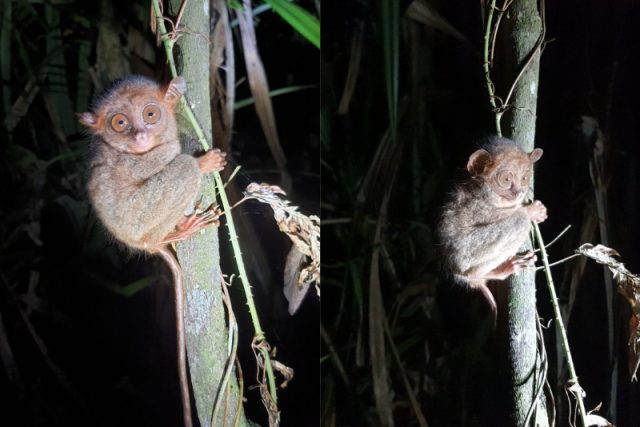
A group of researchers confirmed the presence of a Philippine tarsier in a forest area in Tacloban City.
The University of the Philippines-Visayas Tacloban College posted about this breakthrough on Facebook on August 10.
The UPV-Tacloban College noted that the Philippine tarsier is previously known to be endemic in Mindanao, Bohol, Samar and Leyte only.
A team of researchers from the Division of Natural Sciences and Mathematics (DNSM) of the university, however, has confirmed the presence of this primate in a forest area in Barangay Santa Elena in Tacloban City.
They found the animal during night surveys they conducted from July 29 to 31.
“A team of researchers from the Division of Natural Sciences and Mathematics (DNSM) of the University of the Philippines Visayas Tacloban College (UPVTC) has validated and documented for the first time the presence of Philippine tarsier (Tarsius [Carlito] syrichta), locally known as ‘mago’, in a secondary forest area located in Brgy. Santa Elena, Tacloban City during night surveys conducted on 29-31 July 2022,” the UPV said.
“The survey is part of an ongoing research project on Philippine tarsier in Tacloban City,” it added.
Photos of the tarsier were also provided on the post. They were taken by Associate Professor Richard B. Parilla.
In the post, the UPV stated that the sparse literature about this tarsier species and some reports of their sightings in Tacloban City prompted the researchers to conduct a tarsier population study in the province.
“The Philippine tarsier is found only in the islands of Mindanao, Bohol, Samar, and Leyte. The sparse literature on the Leyte tarsier and anecdotal reports of sightings of the species particularly in the neighboring municipalities of Tacloban City motivated the UP Tacloban researchers to conduct a Philippine tarsier population study in the forests of Tacloban City,” the division said.
This discovery means that Tacloban city has an important role to play as a key biodiversity area that warrants protection.
“The presence of the Philippine tarsier in Tacloban City’s forests highlights the role of the city as a key biodiversity area. The presence of tarsiers and other endemic species should be taken into account in the city’s land-use plans, particularly in terms of protecting the areas where the tarsiers live,” it said.
In an entry in Encyclopedia Britannica, it was stated that other tarsiers (family Tarsiidae) can also be found in different islands across Southeast Asia.
The small creature generally measures only about 9–16 cm (3.5–6 inches), excluding its tail.
“Tarsiers are lemur-like in being nocturnal and having a well-developed sense of smell,” the encyclopedia said.
“However, like monkeys, apes, and humans, they have a nose that is dry and hair-covered, not moist and bald as is that of lemurs. The eyes and placenta are also simiiform in structure,” it added.







